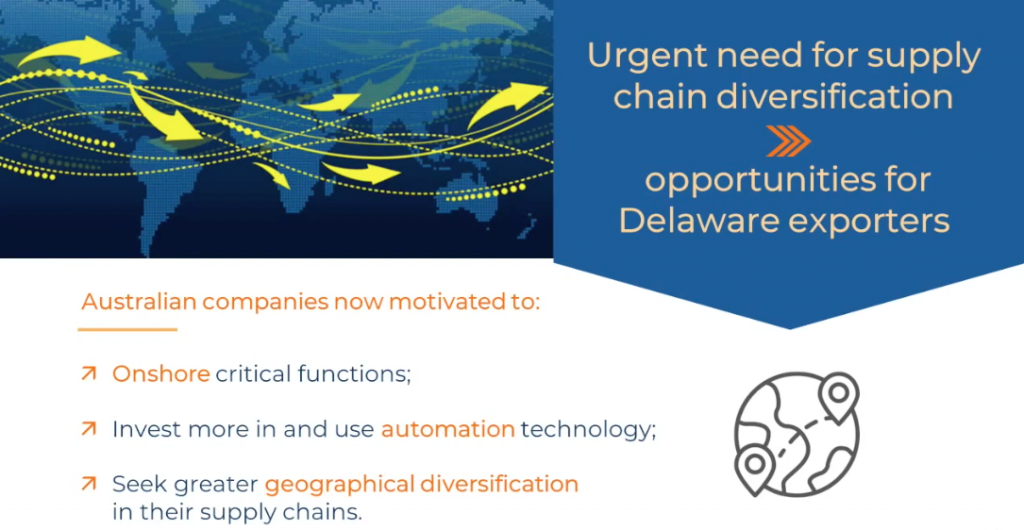

Planning Ahead: What Delaware Exporters Need to Know about Australia and New Zealand
5/6/2020Export Delaware recently caught up with Angela Foley, the state’s international trade representative in Sydney, Australia. Angela and her team help Delaware exporters find new customers in Australia and New Zealand. We connected with Angela to hear about the current “state of play”, in her region, in light of COVID-19, and how it might impact business in the next few years. Watch the full interview here or read the recap below.
https://www.youtube.com/watch?v=b1dV4H_RMO0&t=506s
Australia and New Zealand’s economies have been greatly impacted by COVID-19 and the pandemic has served as a major wakeup call for government and industry leaders. When 2020 began, Australia was entering its 29th year of economic growth. Many young Australians have never experienced a recession. Now Australians are bracing for a 6.7% decrease in economic growth in 2020. The government has delivered a A$320 billion (~US$204bn) stimulus package, the largest it has ever issued. In New Zealand, they expect a 7.2% economic decline in 2020 and have issued a NZ$23 billion (~US$14bn) stimulus.
There is good news, however, as the IMF World Economic Outlook projects a “V-shaped rebound” of +6.1% rebound market growth in Australia and 5.9% in New Zealand in 2021.
Angela recommends that exporters plan for the future by focusing on short term wins in 2020 while, at the same time, also developing a longer term vision and strategy for 2021 and beyond.
Her message is simple – don’t just react – you need to develop a plan. Resources are key at this point and where you allocate them is important. Here’s what she advises for export managers and business owners.

Be Proactive and Plan for the Future
Many export managers are under a lot of pressure right now. They are used to being on the road and meeting face-to-face with customers. There is a concern about what’s coming next. It’s important to develop a strategy now for when restrictions are lifted so you can best evaluate where you will be able to achieve a return on investment.
As you develop that strategy here are a few questions you should be asking:
- How is my industry currently impacted? What is the future outlook?
- How are my existing clients and partners doing? How can I assist them?
- What relevant intelligence and advice can I get from the government, industry experts?
Strong market knowledge and responsible planning are key right now.
Consider the Major Challenges Australia/New Zealand are Experiencing
Australia relies heavily on imports, specifically from China. Through the pandemic, the inbound supply chains were severely disrupted and there are shortages of critical items.
“When China stops, we are impacted here. We’ve received a wake up call,” says Foley
Approximately 80% of medical equipment used in Australia is imported (~40% of this from the U.S.) and ~90% of medicine and pharmaceutical products are imported.
In addition, China is the number one source of building materials for Australian development projects: 69% of furniture, 56% of glass, 40% nuts, screws, and bolts are imported from China.
Local companies have learned a lesson and are rethinking their strategy around sourcing. The nation as a whole is rethinking what they can do from a manufacturing perspective. There is a significant need for supply chain diversification, which opens up opportunities for Delaware exporters, and the fact that Australia has a free trade agreement with the U.S. makes the market especially attractive.

Look for Opportunities in Your Industry/Market
Certain industries have been impacted more than others, and there are opportunities for new product adaptations and applications. In Australia and New Zealand the crisis has accelerated digitalization across many industries. Many retailers were forced to move online during the “stay-at-home” order resulting in an increase in online transactions and eCommerce in general. Increased investments are already being noted in digital health; data analytics, education technology platforms; and cybersecurity. Furthermore, defence sector budgets are also anticipated to increase as the world presses the re-set button to plan for a ‘post Covid-19’ environment.
Agribusiness/Food:
Australia and New Zealand are known as the ‘clean food bowl’ of Asia. Food production is a top priority for both nations, with Australia adding 1 million hectares to grain production in 2020. But, stocks of essential farm inputs are running low, and there is a need for fertilizer, chemicals and agricultural equipment (e.g. tractors, harvesters).
Furthermore, with a shortage of farm labor and high labor costs this industry turns to robotics and artificial intelligence to improve efficiencies. These technologies are being embraced by farmers as the precise method in which they operate (e.g. spreading fertilizers or herbicides in the exact spots where they are required.) can reduce operating costs by 40%.
Digital Health Technologies:
There is a massive rollout of telehealth services with A$1.1 billion (~US$0.7bn) funding boost from the Australian government for telehealth and mental health. More money is being pushed into telehealth than ever before.
In addition to telehealth, there is a need for remote and mobile patient monitoring, online training, specifically courses to up-skill nurses. Smart technologies to keep seniors, and other at-risk individuals, safe at home is also being evaluated.
In Australia, connections with hospital chains and government are critical to breaking into these industries and securing contracts.
Building/Construction:
Federal and State governments are fast-tracking critical infrastructure project. Projects that were planned for 2024 have been moved up in an attempt to keep money flowing through the economy.
Equipment challenges and shortages will be rectified by supplier diversification. Australia and New Zealand can no longer rely solely on China and are seeking new partners from around the world.
Manufacturing:
During the pandemic shortages of supplies were the biggest wake-up call for Australia, and the discussion around onshore production is now back on the political and business agenda. However, Australia realizes she needs to be competitive and believes the best opportunities lie in areas such as smart manufacturing (sensors etc.) and niche markets. Food production, defense, mining and medical engineering are all of critical focus.
Conclusion
Australia and New Zealand have been majorly impacted in early 2020 but both countries are now seeing light at the end of the tunnel as restrictions are being lifted and businesses are gradually being allowed to operate again. There are strong opportunities in both countries for Delaware exporters. The best way for Delaware exporters to develop long term sustainable business opportunities in this region is to focus now on gathering market intelligence and developing a clear plan of action that will carry you through the short-term and the longer-term!

Angela and the Delaware state trade representatives are available to work with your business in providing market research, distributor and customer identification, and virtual zoom meetings for you with clients in their countries. The state has STEP grant funds to support these efforts. If you are interested in having a call with any of our trade representatives to discuss your needs, please contact Beth Pomper at Beth.Pomper@delaware.gov.
Categories: Expand



